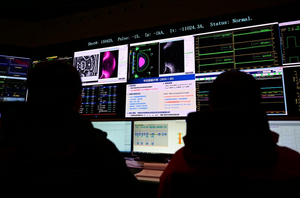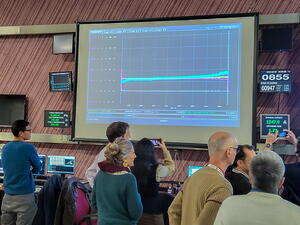Derniers résultats des programmes EAST et WEST
Ces dernières semaines deux tokamaks supraconducteurs—EAST (Chine) et WEST (France)—ont annoncé de nouveaux records. Quel est l’intérêt de ces résultats pour ITER ?
Le 20 janvier, avec le tir de plasma 150425, EAST a franchi pour la première fois le seuil des 1000 secondes en régime permanent et mode de confinement élevé avec un divertor en tungstène (W) et une injection de lithium. Le maintien d’un plasma actif dans ces conditions pendant 1066 secondes à une température proche de 70 millions de °C constitue une étape majeure pour l’équipe EAST, qui a progressivement amélioré les systèmes de chauffage auxiliaire, de contrôle du plasma et de diagnostic du dispositif afin de le rendre plus performant. Ce record s’inscrit dans le prolongement des deux précédentes performances : 100 secondes en 2017 et 403 secondes en 2023.
Dans l’installation WEST, elle aussi équipée d’un divertor en tungstène afin de préparer l’exploitation d’ITER, la décharge 60947 a été maintenue pendant 824 secondes, soit environ le double de la durée et du rapport énergie injectée/extraite enregistrés lors du record du précédent dispositif, le tokamak Tore Supra, qui utilisait un limiteur carbone. Ce résultat fait suite à un record de 364 secondes obtenu l’an dernier.
La production d’impulsions très longues dans ces tokamaks, de l'ordre de celles prévues pour ITER, démontre que les connaissances en matière de contrôle des plasmas à haute température sont au point, explique Alberto Loarte, le responsable de la division Science d’ITER. « Les longues décharges dans un tokamak exigent un haut degré d’intégration et de contrôle afin que ni les processus physiques ni les restrictions technologiques ne limitent leur durée », ajoute-t-il. « Pour cela, il est important de contrôler la configuration du champ magnétique, car les signaux des capteurs peuvent dériver sur les longues périodes de temps et le profil de courant plasma se déforme et peut devenir instable, mais aussi d’évacuer efficacement la chaleur des éléments face au plasma par refroidissement à l’eau afin de stabiliser leur température et, enfin, d’éviter la contamination du plasma par le tungstène, qui peut l’inactiver en raison de pertes excessives de rayonnement. Tous les systèmes utilisés par EAST et WEST pour réaliser des longues décharges ne sont pas repris dans la feuille de route ITER mais l’expérience ainsi accumulée nous est très utile pour identifier les grandes problématiques pratiques et les gérer avec nos propres systèmes. »
Ces résultats des programmes EAST et WEST viennent compléter les nombreux travaux réalisés par les équipes des tokamaks en service à travers le monde, qui travaillent en vue de résoudre les grands défis physiques et technologiques d’ITER, notamment ceux associés à la nouvelle feuille de route, et de tester des scénarios avancés pour les réacteurs de fusion nucléaire du futur.
*Note de l'éditeur : WEST a établi un nouveau record de durée du plasma (1337 secondes) le 12 février 2025. Voir l'annonce du CEA/IRFM.



